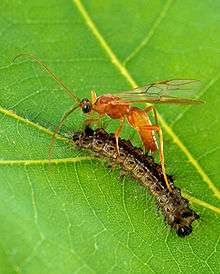Rogadinae
| Rogadinae | |
|---|---|
 | |
| Scientific classification | |
| Kingdom: | Animalia |
| Phylum: | Arthropoda |
| Class: | Insecta |
| Order: | Hymenoptera |
| Family: | Braconidae |
| Subfamily: | Rogadinae |
The Rogadinae are a large subfamily of braconid parasitoid wasps. Several Rogadinae species parasitize pest caterpillars and are important for naturally occurring biological control.
Description and distribution
Rogadinae are small wasps, usually under 8mm long. They are cyclostomes and usually have a medial ridge on the abdomen. They are found worldwide.
Biology
Rogadinae are koinobiont endoparasitoids of Lepidopteran larvae. Females oviposit into host larvae. The host is allowed to develop as the wasp larvae feeds internally on its tissues. Rogadines are unique among braconids in that their host caterpillar is eventually reduced to a mummified husk.The wasp larva then pupate within the mummy. Host mummies are distinctive and can be used to identify the species. Many Rogadinae are nocturnal as adults. [1]
References
- ↑ Wharton, Robert A.; Marsh, Paul M.; Sharkey, Michael J. (1997). Manual of the New World Genera of the Family Braconidae (Hymenoptera). Washington DC: The International Society of Hymenopterists.